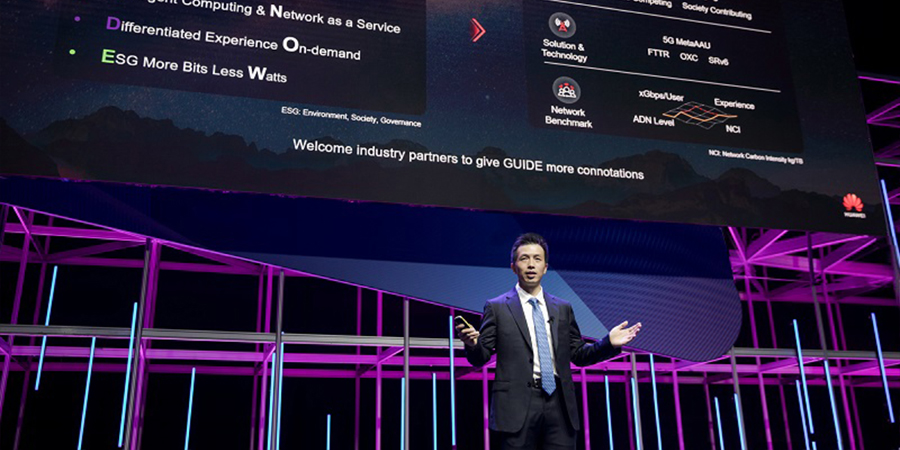During MWC 22 Barcelona which is taking place in Barcelona, Peng Song, president, global carrier marketing and solution sales at Huawei gave an impressive keynote speech discussing network evolution to the future.
In the past year, Huawei released the “GUIDE” Model which tackles 5 main themes: Gigabit everywhere, Ultra-automation, Intelligent multi-cloud connection, Differentiated Experience, and Environmental Harmony. These five key aspects are expected to guide network evolution into the coming digital age.
Song shared in his speech his experience with digitalization over the past year, as well as his thoughts on the evolution of future networks. As a company, Huawei has experienced how digitalization boosts efficiency and service experience. During the pandemic, Huawei invited customers from all over the world to visit the online exhibition hall with an immersive experience to learn more details about its solutions and cutting-edge technologies.
Meanwhile, Song shared, “Last month, during our annual meeting, I virtually presented the award to the outstanding employees in South Africa from where I was in China. During award reception, the audience of over 1000 participants felt like we were standing on the same stage. It was an outstanding experience, however, it is still not 100% perfect. For example, the online award presenting process was not smooth enough. There were little delays, some renderings were barely satisfactory because cloud and network convergence were not good enough.”
Song also pointed at some disadvantages like when customers visited their online exhibition hall, the team must manually ensure a good network experience as the network is not yet fully automated. In addition, the network can only be accessed from places like offices that can provide sufficient bandwidth and guaranteed SLA.
Talking about ICT technologies, a lot of cutting-edge innovations were set up at the International Sports Game in Beijing, which has just concluded. Along a 10-kilometer road at Shougang Park, 17 5G base stations were deployed to enable an L4 autonomous driving network:
- Unmanned delivery vehicles were used to deliver takeout food to designated locations, and send messages to attendees to let them know their meal had arrived.
- Spectators could flag down mobile vending machines when they needed to buy anything. After the purchase was made, they would move along in search of their next customer.
- Driverless taxis and vans carried athletes to and from event venues.
The longstanding dream of an era of self-driving vehicles became a reality at Shougang Park thanks to the 5G intelligent IoV system.
Moreover, during this event, many people were lucky to try the world's first 5G high-speed train. More than 300 5G base stations were deployed along a 200-kilometer railway and passengers could watch 4K live streaming fluently even though the train was running at the speed of up to 350 kilometers per hour. Passengers were also able to follow the events from any angle and see athletes' spectacular moves in bullet time. The experience was similar to that of 360-degree HD VR.
According to Song, in the near future, these innovations will surely go beyond stadium levels. People will be freed from the constraints of time, distance, and biology, and the boundary will be broken between the real and the virtual world.
Humans never stop to pursue the ultimate experience and imagination, which is limitless, is what determines how far we can go.
At Huawei Connect 2021, Huawei published the Intelligent World 2030 report. The report predicts that by 2030, globally, there will be more than 200 billion connections, as all things will be connected with intelligence; and there will be 1.6 billion fiber broadband subscribers; holographic communication and humanized space will become possible based on the 10Gbps home broadband. Further on, Huawei is set to explore the outer space and ocean, and use next-generation networks to build both space and underwater cities. Huawei also plans to explore the human brain in an effort to unlock human mysteries and break biological limits, using wireless connectivity and AI technologies.
For this to happen in 2030, what should we be doing right now to evolve our networks and seize the opportunities of digitalization? The definition of the “GUIDE” needs to be expanded. This is why Huawei is proposing “GUIDE is Now”, Song explains. which they define as building ubiquitous gigabit connectivity, speeding up ultra-automation to address uncertainties, providing intelligent computing and networks as a service, offering differentiated experiences on demand, and enabling sustainability with green ICT.
GUIDE creates a future-proof three-layer structure. First, GUIDE outlines the future as it is Huawei’s proposal for a shared business vision for the digital world, which integrates service development, operational efficiency, business value, and social contribution.
Second, GUIDE addresses the coming together of technology and business. At this year's MWC, Huawei will launch some of its latest products and technologies, such as 5G MetaAAU, FTTR, and OXC.
Finally, GUIDE creates network measurement benchmarks, as a guide of planning for markets at different stages of development to find the most suitable path for the network evolution.
GUIDE accelerates the integration of connectivity with green and intelligent technologies, while leveraging business value to allow connectivity innovation to bear fruit.
“Once the wheel of digitalization starts to roll, nothing can stop it”, Song concluded.










